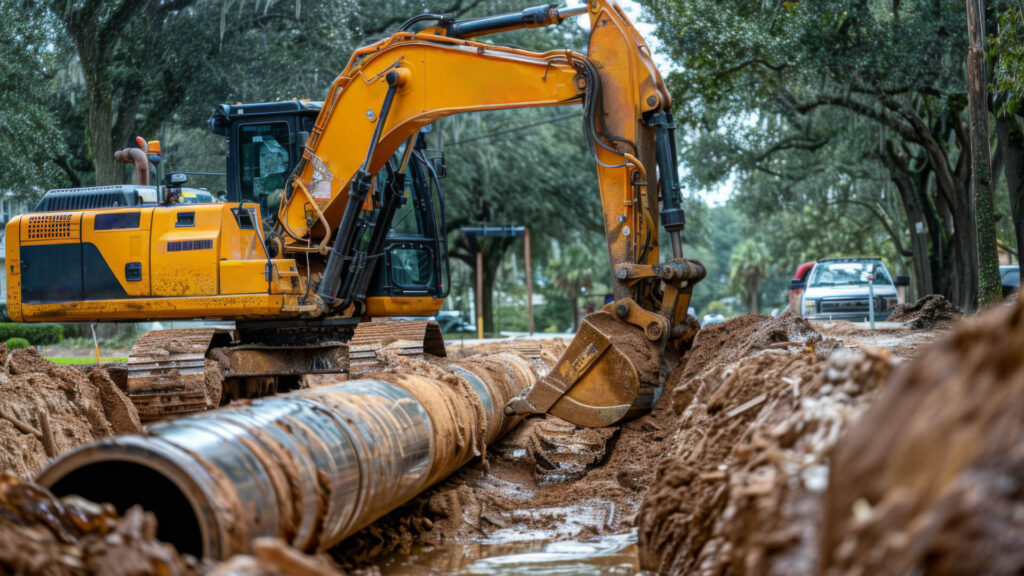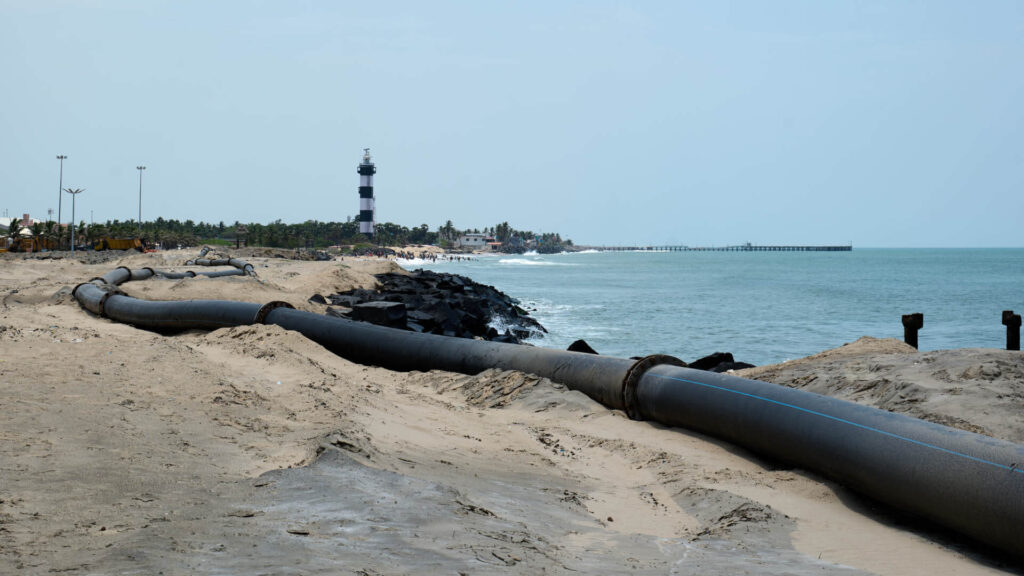In large-scale construction projects, especially those involving dredging operations, connecting dredge pipelines is a critical process. These pipelines transport dredged material, including sediment and slurry, from the extraction site to designated disposal or processing areas. Efficiently connecting dredge pipelines not only affects project efficiency but also contributes to cost management and environmental safety. This article explores various dredge pipeline connection methods and the essential tools for connecting pipelines, ensuring optimal performance in construction projects.
The Role of Dredge Pipelines in Construction
Dredge pipelines are crucial in construction projects involving land reclamation, sediment removal, and waterway maintenance. Their primary function is to transport a mixture of sediment, water, and other materials from one location to another. This process is vital for keeping waterways navigable, expanding usable land, and managing sediment accumulation.
Well-maintained construction pipeline connections are key to a successful dredging project. Properly connecting dredge pipelines helps prevent leaks, minimize pressure loss, and avoid system breakdowns, which could otherwise cause significant project delays. By ensuring efficient construction pipeline connections, project teams can improve productivity, reduce downtime, and avoid costly repairs or replacements. Moreover, efficiently connecting dredge pipelines plays a crucial role in preventing environmental damage by minimizing the risk of leaks.
Common Dredge Pipeline Connection Methods
There are several dredge pipeline connection methods used in the construction industry, each offering unique advantages depending on the project’s specific requirements. Below are some of the most common methods:
Mechanical Couplings
Mechanical couplings are one of the most widely used dredge pipeline connection methods. These couplings consist of metal clamps that secure two pipe ends together. They are valued for their versatility and ease of installation, making them suitable for both temporary and long-term projects. Mechanical couplings are especially useful in applications where pipelines need to be frequently assembled and disassembled.
However, mechanical couplings can wear down over time, particularly in harsh environments. Regular maintenance and inspection of these construction pipeline connections are essential to ensure that they remain secure and effective for connecting dredge pipelines.
Flanged Connections
Flanged connections involve attaching two pipe sections with metal flanges that are bolted together. This method creates a strong, leak-resistant seal, making it ideal for projects requiring long-term stability. Flanged connections are often used for more permanent installations where the risk of leaks or system failure must be minimized.
While flanged connections provide durability, they require more labor to install. Proper alignment and torquing of the bolts are critical to ensure a tight seal, requiring specific tools for connecting pipelines and skilled personnel. Once installed, however, flanged connections are known for their longevity and ability to withstand the pressures of heavy-duty construction projects.
HDPE Fusion Welding
High-density polyethylene (HDPE) fusion welding is a modern method used to connect plastic pipelines. In this process, the pipe ends are heated and fused together, creating a seamless and leak-free connection. HDPE fusion welding is especially useful in environmentally sensitive areas, where minimizing the risk of leaks is paramount.
HDPE fusion welding offers a strong, leak-proof seal without the need for mechanical parts. However, it requires specialized welding equipment and trained operators, which can increase initial project costs. Despite these costs, the method is highly efficient and reliable, especially for long-term projects, where the reduction in maintenance and repair costs can offset the upfront expenses. This method is often ideal for connecting dredge pipelines in environmentally delicate areas.
Each of these dredge pipeline connection methods offers different advantages in terms of durability, ease of installation, and cost. Choosing the right method depends on factors such as the pipeline material, environmental conditions, and project duration.

Essential Tools for Connecting Dredge Pipelines
Using the right tools for connecting pipelines is essential to ensure secure and efficient connections. These tools help streamline the installation process and improve the reliability of construction pipeline connections. Below are some of the most commonly used tools:
Pipe Welding Machines
Pipe welding machines are essential for projects using HDPE fusion welding as one of their dredge pipeline connection methods. These machines apply heat to the pipe ends, allowing them to be seamlessly fused together. Modern pipe welding machines are often automated, improving the speed and consistency of the connection process. These machines are critical to ensure strong, durable connections when connecting dredge pipelines.
Bolt Tensioners and Hydraulic Torque Tools
When flanged connections are used, bolt tensioners and hydraulic torque tools are indispensable. These tools for connecting dredge pipelines ensure that the bolts securing the flanges are tightened to the correct specifications, creating a reliable, leak-proof seal. Proper torquing of the bolts is essential to the long-term durability of flanged construction pipeline connections.
Dredge Pipe Clamps and Sealing Systems
Mechanical couplings rely on strong clamps and effective sealing systems to keep pipes securely connected. These tools for connecting pipelines are designed to withstand the high pressure and harsh conditions common in dredging operations. High-quality clamps and sealing systems prevent leaks and extend the life of construction pipeline connections, particularly in challenging environments. This makes them essential in projects that require frequent connecting dredge pipelines.
Using the correct tools for connecting dredge pipelines not only speeds up the installation process but also ensures that the connections are reliable and long-lasting. The proper selection and use of these tools can significantly reduce the likelihood of leaks, breakdowns, and other issues that could delay construction projects.
Best Practices for Efficient Dredge Pipeline Connections
To ensure the success of dredging operations, it is essential to follow best practices when connecting dredge pipelines. These practices enhance the reliability of construction pipeline connections and prevent operational setbacks:
Regular Inspection and Maintenance
Routine inspection and maintenance of dredge pipeline connections are crucial. Mechanical couplings, in particular, should be regularly checked for wear, such as loose bolts or degraded seals. Identifying and addressing potential problems early on can prevent costly system failures and project delays. This proactive approach to connecting dredge pipelines ensures longevity and operational success.
Proper Alignment and Tensioning
Proper alignment of pipelines during connection is essential for avoiding stress on the system. Misaligned pipes can create pressure points that may lead to cracks, leaks, or even full-scale pipeline failures. Additionally, when using flanged connections, ensuring that all bolts are evenly tightened is critical for creating a secure and leak-proof connection. Achieving proper alignment is a key factor in ensuring the successful connecting of dredge pipelines.
Environmental Considerations
In environmentally sensitive areas, it’s vital to prevent leaks that could harm local ecosystems. HDPE fusion welding is often the best option for creating seamless connections in such projects. Moreover, selecting the appropriate dredge pipeline connection methods based on environmental factors helps reduce the project’s overall impact. Efficient connecting of dredge pipelines in these areas can significantly minimize the environmental risks associated with dredging operations.
By adhering to these best practices, project teams can ensure that their construction pipeline connections are efficient, durable, and environmentally sound.
Conclusion
Efficiently connecting dredge pipelines is a critical component of any construction project involving dredging operations. Choosing the best dredge pipeline connection methods and using the right tools for connecting pipelines can make a significant difference in project efficiency, cost control, and environmental safety. By following best practices such as regular inspection, proper alignment, and attention to environmental considerations, construction teams can create reliable, long-lasting construction pipeline connections that enhance project outcomes. Proper connecting dredge pipelines not only improves productivity but also minimizes the risk of costly downtime and environmental damage, ensuring the overall success of the construction project.


